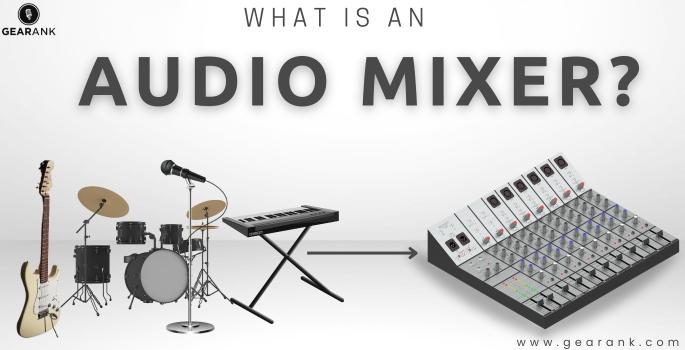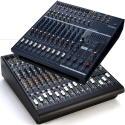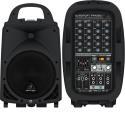What is an Audio Mixer? The Art of Combining Audio Sources

Whether setting up a home studio or starting a podcast, you must purchase your first audio mixer. An audio mixer is an electronic device that allows you to handle multiple audio signals while providing effects like tone, placement, and volume.
In professional settings, an audio mixer may be called a mixer or soundboard, and it's used for both live events and recording to produce the best possible sound quality.
In this article, we'll briefly overview what an audio mixer is and how it works.
The Different Types Of Audio Mixers
For those familiar with audio equipment and technical terms, when searching for mixing boards to pair with an audio interface, there are two types: In-Line and Split Monitor.
In-line mixers feature dual pathways for each channel, which enables simultaneous transmission and reception of two audio channels to and from a digital audio workstation (DAW) using the same channel.
A Split Monitor mixing console, on the other hand, offers a single path per channel. This type of mixer allows a DAW to send or receive audio through multiple sources on each channel.
What Makes Up A Channel?
Regarding audio mixing, the term "channel" is frequently used. A channel strip is a path for the signal. A sound mixer typically has multiple input channels and channel strips. These channel strips contain the same buttons and features per channel, allowing you to adjust settings like gain, equalization, compression, and the track's level.
Here are the main features you'll find on a channel strip:
Inputs
This section of the mixer deals with the input signal that is connected to it, such as a microphone or instrument. Depending on the signal level, certain control knobs and switches need to be engaged.
For example, if a microphone is connected, the channel needs to be set up to take mic-level signals, and the mic pre-knob must be turned up to increase the signal's gain.
On the other hand, instrument inputs are designed to cater to different instruments, including guitars, keyboards, bass, electronic drums, etc.
Some mixers have expanded input sections with line level inputs for line level signal processing and sound mixing.
Auxes
Auxiliaries, also known as "auxes", send a copy of the channel's signal to a different location. They have a designated space on the channel and are commonly used in recording studios to add time-based effects to vocals, such as reverb or delay, or to create a customized headphone mix.
On a live sound console, auxes can be used to broadcast audio to in-ear monitors and can also be used for time-based effects.
Dynamics
In audio mixing, the dynamics section is dedicated to processing the dynamic range. Compressors and gates are the most commonly used dynamic range processors.
Compressors balance the sound of the singer or instrument, adjusting the loud sections to be softer and the soft sections to be louder.
On the other hand, noise gates are used to cut out unwanted sounds or interference. This is done by setting a threshold below which sounds are automatically muted.
Pan
In audio engineering, panning distributes a sound signal's perceived location in the stereo field. One or two pan pots on an in-line mixer can control this, each assigned to a specific path. A pan pot is typically located above the fader on a dual monitor workstation.
Pan pots can also assign channels to auxiliary output channels, which is particularly useful in mono sound system setups.
Equalization
The channel strip comprises an equalization (EQ) zone that plays a crucial role in audio frequency adjustment, enhancing the listening experience. EQ is composed of two parts: center frequency and bandwidth. Advanced audio mixers come with more specific frequency targeting, empowering you with better control.
To better utilize EQ, you need to do a proper sound check before perrformance.
Faders
The fader controls the level of detectable sound from the channel by increasing or decreasing it. Some models have both pre-fader and post-fader options for the signal level of each channel.
Faders act similarly to resistors; as they are lowered, their resistance increases. Each channel's fader is marked with decibels with zero as unity gain. So they can be used as boost when you go above unity gain, or as a passive attenuation device, when you go lower.
These values indicate the volume level and loudness of the output signals.
Phantom Power
Each channel on a mixer typically has a phantom power switch to supply 48 volts of direct current via the XLR cable, which is necessary for condenser microphones.
Is Anyone Capable Of Audio Mixing?
Audio mixing is the process of combining multiple signals and merging them into a single track. This task requires technical expertise in sound compression, equalization, reverb, and other audio effects.
Whether it's music, speech, sound effects, or other audio, mixing requires industry-standard techniques to ensure the final product sounds polished and professional. For those with the necessary skills, sound mixing is a challenging yet rewarding task that requires a blend of technical proficiency and creative flair.
Conclusion
For those well-versed in audio production, an audio mixer is an indispensable tool for enhancing sound quality and improving recordings. The benefits of using an audio mixer are numerous, and once you become familiar with its functionalities, you'll wonder how you ever worked without one.
With its capability to control multiple audio channels, apply effects, and adjust levels, an audio mixer can help you achieve a professional-grade output that meets the highest quality standards.
This article has hopefully provided valuable insights into the importance of sound mixers in music production.
Frequently Asked Questions
What Are The Different Types Of Audio Mixers?
Analog and digital mixers are two options for recording and processing sound and audio. They are found in sound systems, from the most basic PA system, to the complex. While both serve the same purpose, they differ in the technology used.
An analog mixer uses electrical signals to process audio, while a digital mixer converts sound into binary code for processing.
The resulting sound quality and capabilities differ, with analog mixers typically offering more warmth and character and digital mixers providing precise control and advanced features.
If you're looking for recommendations, we have a guide that features the best powered PA mixers, note that the guide comes with affiliate links.
Why Do You Need An Audio Mixer?
An audio mixer is a versatile tool that offers several advantages for audio production. It enables users to add sound effects, reduce noise levels, and enhance audio quality.
An audio mixer can provide more control over the final audio mix by allowing the user to adjust different sound sources individually.
Additionally, advanced audio mixers offer equalization, compression, and routing options, enabling users to fine-tune the audio output to meet their specific requirements.
Do You Need An Amplifier For Your Audio Mixer?
A mixer is a standalone device that doesn't necessarily need an amplifier to function correctly.
Contributors:
- Jerry Borillo - Illustrator












